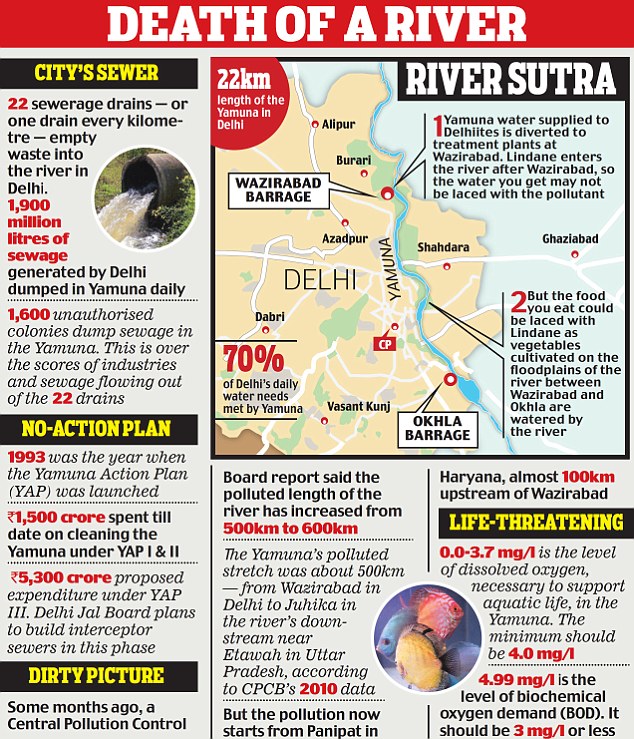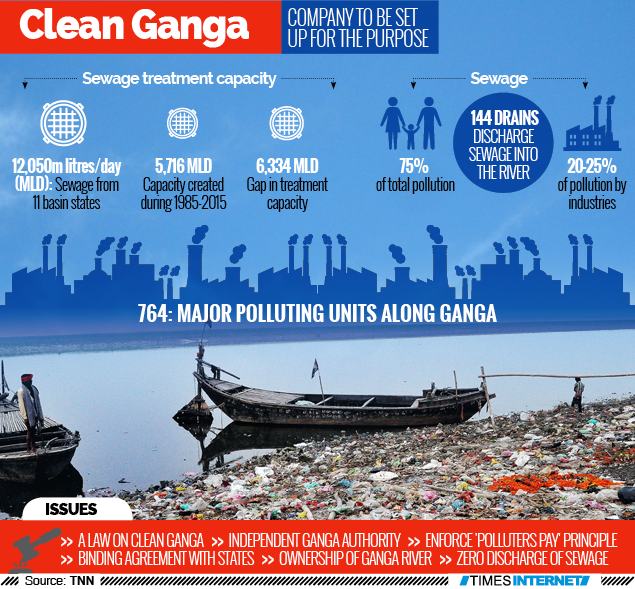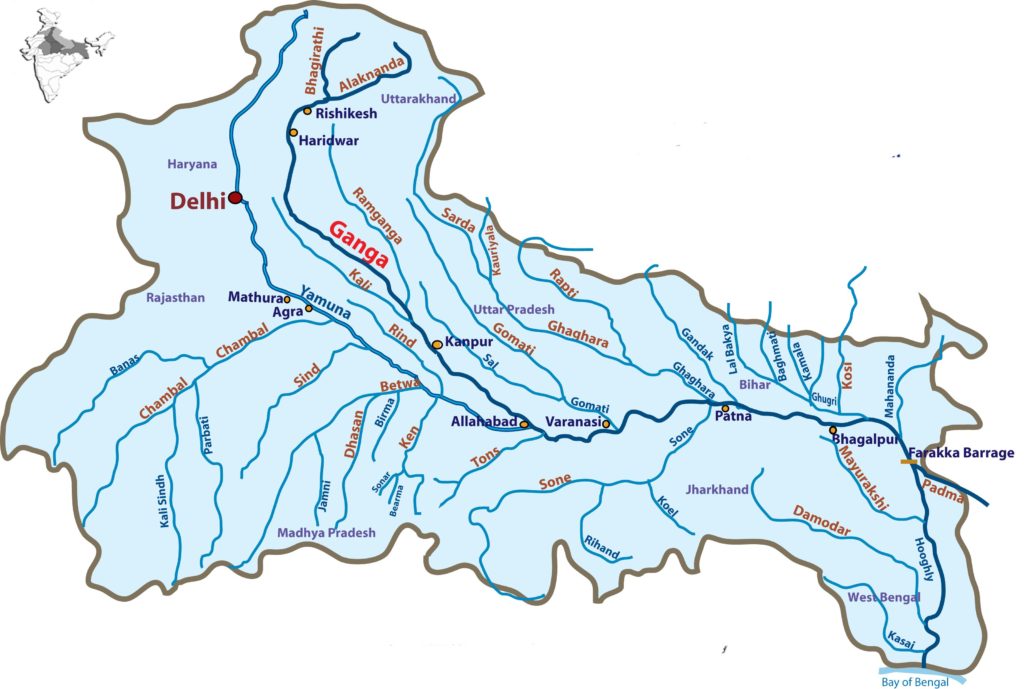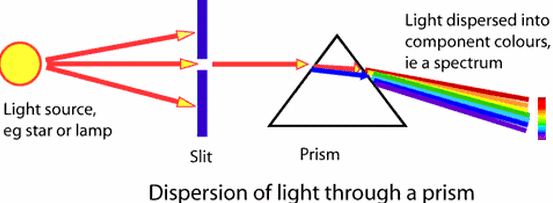Contents
- U.P. pollution control body pulled up for Ganga’s plight
- Process: transfer of HC Judge
- February 28: National Science Day
- Govt to establish Central Consumer Protection Authority
U.P. POLLUTION CONTROL BODY PULLED UP FOR GANGA’S PLIGHT
Why in news?
- The Central Pollution Control Board (CPCB) has pulled up the Uttar Pradesh Pollution Control Board (UPPCB) for its inability to prevent drains in Kanpur from polluting the Ganga
- Over a thousand industries, including sugarcane, pulp and paper and tanneries, and slaughter houses had been marked out and monitored for effluent load

Background:
Central Pollution Control Board:
- The Central Pollution Control Board (CPCB) of India is a statutory organisation under the Ministry of Environment and Forests (MoEF).
- It was
established in 1974 under the Water (Prevention and Control of pollution)
Act, 1974.
CPCB is also entrusted with the powers and functions under the Air (Prevention and Control of Pollution) Act, 1981. - It serves as a field formation and also provides technical services to the Ministry of Environment and Forests under the provisions of the Environment (Protection) Act, 1986.
- It Co-ordinates the activities of the State Pollution Control Boards by providing technical assistance and guidance and also resolves disputes among them.
- It is the apex organisation in country in the field of pollution control, as a technical wing of MoEF

The Ganga River System:
Source of origin: The Ganga rises from the Gangotri glacier near Gomukh in Uttarkashi district of the state of Uttarakhand.
Confluence or Mouth: The Ganga river drains into the Bay of Bengal before forming a very huge delta.
The
Ganga is called the Bhagirathi above Devprayag and below this town, the Ganga.
The Ganga initially flows in the southern direction, then in the south-east
direction up to Mirzapur and then in the east direction in the Bihar plains.
Near the Rajmahal hills, it turns into south-east direction and after flowing
some distance in Murshidabad district of West Bengal, it enters Bangladesh.
In Bangladesh, it gets divided into two main distributaries- the Bhagirathi and
the Hugli.
The main river goes to Bangladesh where it is firstly known by the name of the
Padma and then the Meghna which drains into the Bay of Bengal.

The Five Prayags
- Devaprayag, the place of confluence of Bhagirathi river and Alaknanda river.
- Rudraprayag, the place of confluence of Mandakini river and Alaknanda river.
- Nandaprayag, the place of confluence of Nandakini river and Alaknanda river.
- Karnaprayag, the place of confluence of Pindar river and Alaknanda river.
- Vishnuprayag, the place of confluence of Dhauliganga river and Alaknanda river.
Ganga River Tributaries:
| River | Source |
| Bhagirathi (Ganga) | Gangotri glacier |
| Yamuna | Yamnotri glacier on the Bandarpunch Peak |
| Chambal | Janapao Hills in the Vindhya Range |
| Banas | Aravali Range |
| Betwa | Bhopal district |
| Ken | Barner Range |
| Son | Amarkantak Plateau |
| Damodar (‘Sorrow of Bengal’) | Chotanagpur plateau |
| Ramganga River | Garhwal district of Uttarakhand |
| Ghaghra River | Gurla Mandhata peak, south of Manasarovar in Tibet (river of the trans-Himalayan origin) |
| The Kali River (border between Nepal and Uttarakhand) | Glaciers of trans-Himalayas |
| Gandak River | Tibet-Nepal border |
| Burhi Gandak | Sumesar hills near the India-Nepal border |
| Kosi (‘Sorrow of Bihar’) | Tumar, Arun and Sun Kosi unite at Triveni north of the Mahabharata Range to form the Kosi. |
| Consider the following statements. 1. Ganga action plan started in the year 1986 2. It is a 100% centrally sponsored program 3. Yamuna action plan started under national river conservation plan Which of the following is/are correct? A) 1,2 only B) 2,3 only C) 1,3 only D) All of the above Answer: D |
PROCESS: TRANSFER OF HC JUDGE
Why in news?
The late 26th February notification of the Law Ministry, notifying the transfer of Justice S. Muralidhar from the Delhi High Court to the Punjab and Haryana High Court triggered a political war of words on 27th February between the Union government and the Congress party.
Details
- The constitutional provision is contained in Article 222: ‘The President, after consultation with the Chief Justice of India, may transfer a judge from one High Court to any other High Court.’
- After the Supreme Court judgments on appointments and transfer of judges of 1982, 1983, 1998 and 2015, the government has been disempowered from making decisive decisions in this regard.
- The power rested with the collegiums of Supreme Court judges.
Constitutional position:
- Article 222 of the Constitution makes provision for the transfer of a Judge (including Chief Justice) from one High Court to any other High Court.
- The initiation of the proposal for the transfer of a Judge should be made by the Chief Justice of India(CJI).
- The opinion of the CJI “is determinative”.
- Consent of a Judge for his first or subsequent transfer would not be required.
- In the formation of his opinion for the transfer of a Judge, other than the Chief Justice, the CJI is expected to take into account the views of the Chief Justice of the High Court from which the Judge is to be transferred and Chief Justice of the High Court to which the transfer is to be effected.
- The views of one or more Supreme Court Judges who are in a position to offer his/their views are also taken into account.
- In the case of transfer of a Chief Justice, only the views of one or more knowledgeable Supreme Court Judges need to be taken into account.
- The views on the proposed transfer of a Judge or a Chief Justice of the High Court should be expressed in writing and should be considered by the CJI and the four senior most Judges of the Supreme Court.
- The proposal should be referred to the Government of India.
- Then the Union Minister of Law would submit a recommendation to the Prime Minister who will then advise the President as to the transfer of the Judge concerned.
- After the President approves the transfer, the notification will be gazetted and the judge remains transferred.
Collegium System:
- Collegium system was born through “three judges case” and it is in practice since 1998. It is used for appointments and transfers of judges in High courts and Supreme Courts.
- There is no mention of the Collegium either in the original Constitution of India or in successive amendments
The Supreme Court has given different interpretations of the word ‘consultation’ in the above mentioned provisions.
- In the First Judges case (1982), the Court held that consultation does not mean concurrence and it only implies exchange of views.
- In the Second Judges case (1993), the Court reversed its earlier ruling and changed the meaning of the word consultation to concurrence.
- In the Third Judges case (1998), the Court opined that the consultation process to be adopted by the Chief Justice of India requires ‘consultation of plurality judges’.
- The sole opinion of the CJI does not constitute the consultation process. He should consult a collegium of four senior most judges of the Supreme Court and even if two judges give an adverse opinion, he should not send the recommendation to the government.
- The court held that the recommendation made by the chief justice of India without complying with the norms and requirements of the consultation process are not binding on the government.
Issues the Collegium system:
The norm of the Supreme Court collegium not to make public, the reasons for transfers and maintaining opaqueness are contributing to an erosion of the judiciary’s credibility and its image of being independent in its functioning from the executive. This also invariably makes the High Court judges look subordinate to the Supreme Court collegium.
Collegium, which is not a constitutional body has monopoly over transfer of judges. The small base from which the selections are made and the secrecy and confidentiality ensured, on many occasions lead to wrong appointments based on past favours instead of merit or seniority as well as nepotism.
The attempt made to replace it by a ‘National Judicial Appointments Commission’ was struck down by the court in 2015 on the grounds that it posed a threat to the independence of the judiciary. Dissenting judge, Justice J. Chelameswar, termed it “inherently illegal”.
In an effort to boost transparency, the Collegium’s resolutions are now posted online, but the reasons are not given.
The consultative process that had been put into place to guard the judiciary against arbitrary transfers has been criticised for itself becoming arbitrary. The case of Justice Tahilramani fits into this framework where the public is left with no information on why the transfer was made.
Way forward:
- In the Union of India v Sankal Chand Sheth case (1977), the actual transfer of the judge was withdrawn and Justice PN Bhagwati, had stated that to transfer without consent was inimical to the independence of the judiciary. Henceforth, Justice Bhagwati’s view of no transfer without consent needs to be followed.
- To make the system more transparent and declare the reasons for transfer of the judges.
- Merit and seniority should be given an upper hand while making transfers rather than personal interests.
| Consider the following statements: (Prelims 2019) 1. The motion to impeach a Judge of the Supreme Court of India cannot be rejected by the Speaker of the Lok Sabha as per the Judges (Inquiry) Act, 1968. 2. The Constitution of India defines and gives details of what constitutes ‘incapacity and proved misbehaviour’ of the Judges of the Supreme Court of India. 3. The details of the process of impeachment of the Judges of the Supreme Court of India are given in the Judges (Inquiry) Act, 1968. 4. If the motion for the impeachment of a Judge is taken up for voting, the law requires the motion to be backed by each House of the Parliament and supported by a majority of total membership of that House and by not less than two-thirds of total members of that House present and voting. Which of the statements given above is/are correct? (a) 1 and 2 (b) 3 only (c) 3 and 4 only (d) 1, 3 and 4 Answer: (c) 3 and 4 only |
FEBRUARY 28TH: NATIONAL SCIENCE DAY
28th February is celebrated as National Science Day (NSD) in India. NSD is celebrated to commemorate discovery of the ‘Raman Effect’, which led to Sir C.V. Raman winning the Noble Prize.
When was the day declared as National Science Day?
In 1986, the National Council for Science and Technology Communication (NCSTC) asked the Government of India to designate 28 February as National Science Day which the then Govt. of India accepted and declared the day as National Science Day in 1986. The first National Science Day was celebrated on February 28, 1987.
What is Raman Effect?
- Raman Effect is a phenomenon in spectroscopy discovered by the eminent physicist Sir Chandrasekhara Venkata Raman in 1928.
- After two years in 1930, he got Nobel Prize for this remarkable discovery and this was the first Nobel Prize for India in the field of Science.
- Raman Effect is a change in the wavelength of light that occurs when a light beam is deflected by molecules.
- When a beam of light traverses a dust-free, transparent sample of a chemical compound, a small fraction of the light emerges in directions other than that of the incident (incoming) beam.
- Most of this scattered light is of unchanged wavelength.
- A small part, however, has wavelengths different from that of the incident light; its presence is a result of the Raman Effect.

About Sir Chandrashekhara Venkata Raman
• Dr. C. V. Raman was born on November 07, 1888 in the then Madras Presidency (Tamil Nadu) in British India. His father was a professor of mathematics and physics.
• C. V. Raman completed his BA from the Presidency College in Madras and completed his MA in Physics from the same college.
• C.V. Raman got a government job and tried for a career in the science field. He participated in various scientific competitions and the Finance Department of the Government of India selected him for a scholarship.
• He continued to research the laboratories of the Indian Association for Cultivation of Science and the University of Calcutta.
• He researched the spectrum nature of steel, fundamental issues of steel dynamics, the structure, and properties of diamonds and the optical behavior of many pigmented materials. He was the first to discover the harmonic nature of the tabla and mridangam.
• The Government of India honoured him with the highest civilian award, the Bharat Ratna in 1954.
GOVERNMENT TO ESTABLISH CENTRAL CONSUMER PROTECTION AUTHORITY
What is the Central Consumer Protection Authority?
- The authority is being constituted under Section 10(1) of The Consumer Protection Act, 2019.
- The Act replaced The Consumer Protection Act, 1986, and seeks to widen its scope in addressing consumer concerns.
- The new Act recognises offences such as providing false information regarding the quality or quantity of a good or service, and misleading advertisements.
- It also specifies action to be taken if goods and services are found “dangerous, hazardous or unsafe”.
- The CCPA aims to protect the rights of the consumer by cracking down on unfair trade practices, and false and misleading advertisements that are detrimental to the interests of the public and consumers.
- The CCPA will have the powers to inquire or investigate into matters relating to violations of consumer rights or unfair trade practices suo motu, or on a complaint received, or on a direction from the central government.
For manufacture, selling, storage, distribution, or import of adulterated products, the penalties are:
- If injury is not caused to a consumer, fine up to Rs 1 lakh with imprisonment up to six months;
- If injury is caused, fine up to Rs 3 lakh with imprisonment up to one year;
- If grievous hurt is caused, fine up to Rs 5 lakh with imprisonment up to 7 years;
- In case of death, fine of Rs 10 lakh or more with a minimum imprisonment of 7 years, extendable to imprisonment for life.
What other powers will the CCPA have?
- While conducting an investigation after preliminary inquiry, officers of the CCPA’s Investigation Wing will have the powers to enter any premise and search for any document or article, and to seize these. For search and seizure, the CCPA will have similar powers given under the provisions of The Code of Criminal Procedure, 1973.
- The CCPA can file complaints of violation of consumer rights or unfair trade practices before the District Consumer Disputes Redressal Commission, State Consumer Disputes Redressal Commission, and the National Consumer Disputes Redressal Commission. It will issue safety notices to alert consumers against dangerous or hazardous or unsafe goods or services.




